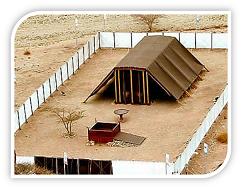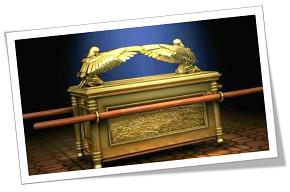The Message of the Tabernacle
The Message of the Tabernacle
From Exodus chapter 25 to chapter 40 we read of the making of the Tabernacle, which served Israel as their temple when they were in the wilderness. Moses was given very minute instructions as to every detail of this tabernacle and its furnishings. He was solemnly charged by God, "see that thou make all things according to the pattern that was showed thee in the mount" (Heb. 8:5 and Ex. 25:40). Why was all this detail given, and why is it all so carefully recorded in our Bible? We are told that, "whatsoever things were written aforetime, were written for our learning" (Rom. 15:4). I am inclined to believe that the tabernacle and its layout, and its furnishings were designed by God to be a kind of visual aid, whereby He could teach Israel, and us, certain fundamental lessons about God, and salvation. Think for example about the ark.
The Tabernacle was pitched in the very center of the camp of Israel. There was a large outer court shut off from the camp by linen curtains, and a single entrance on the east side. Inside this enclosure stood the altar of burnt offering, and beyond this was the brass laver, where the priests were required to wash their hands and feet. The Tabernacle itself was a rectangular tent, which was divided into two apartments. The first contained the golden lampstand, the table of showbread, and the golden altar of incense. Behind this altar was the vail; a curtain which hung from the ceiling to the floor, and which stretched right across the tent from one side to the other, so as to shut off the further apartment which was called the Holy of Holies. This vail was never left open. Inside was the ark of the covenant. It was a box made of acacia wood and covered over both inside and outside with plates of gold. The lid was called the Mercy Seat. It was one slab of solid gold, and at each end there was the figure of a cherub made of beaten gold. Inside the ark were the two tables of stone on which were written the ten commandments. Now what did God intend to teach Israel, and us, in all this?
God is a Spirit⤒🔗
In the Holy of Holies there was no visible presence of God, nor was there any image. Now Israel had come out of Egypt where there were many temples, and each one had in it some idol to be worshipped. Some of their temples had a similar layout to the Tabernacle. They had an outer court, and inside this was the temple building, which like the tabernacle had two apartments. In the innermost of these was an ark; but it was a shrine. It had doors in the front which opened to reveal the idol which was to be worshipped. Now see the difference here. Inside the ark there was no image of any god to be worshipped; but simply the two tables of stone with the ten commandments. But what of the cherubim? Were they worshipped? What were the cherubim? We read of them in Gen. 3, when Adam and Eve sinned God cast them out of the garden of Eden, and placed cherubim, and a flaming sword which turned every way, to keep the way to the tree of life. Here in the tabernacle they are looking down on the Mercy Seat as if they worshipped. The Cherubim are represented in scripture as being always near to God: "Thou that dwellest between the cherubims, shine forth" (Ps. 80:1, 99:1). So here these figures of the cherubim meant that God was really present, but he is a Spirit and not visible. Since He is a Spirit there could be no image. This was the clear message and plain for all to read.
God is holy, and righteous←⤒🔗
Holy means set apart. God is the One who is set apart from everything else in the universe, for He created it all. He is far above anything that is in heaven, or on earth, so that He alone is to be worshipped, and there can be no image of the invisible God. "No man hath seen God at any time, the only begotten Son which is in the bosom of the Father, He hath declared Him" (Jn. 1:18). God is righteous. Inside the ark there was no image, but simply the two tables of the law. This law is the standard of God's righteousness. It must never be broken, or set aside; it must always be observed and honored. This was the standard of righteousness that God required of men. It sets forth God's will for man, it is the law of happiness. Only as it is kept can we be truly happy; so we learn here God's care for men.
 Notice that the Cherubim are looking down on the Mercy Seat. There on the Mercy Seat are stains of blood. Every year on the Day of Atonement, the High Priest of Israel was commanded to offer a sin offering, and to bring the blood into the Holy of Holies and sprinkle it before the ark, and on the Mercy Seat. This was because Israel had sinned, and broken God's law. God could never tolerate sin, and if He was to dwell in the camp of Israel, and be their God, then their sin must be confessed, and the sacrifice appointed by God must be offered, and the blood sprinkled in this way … Here than we are taught something of the righteousness of God, and also of His mercy. It was God who desired to dwell among His people. It was God, who showed how this could be. The sacrifice was not man's idea, it was God's plan, and it must be the sacrifice which God appointed, not just what they chose to offer; and it must be offered by the priest whom God appointed.
Notice that the Cherubim are looking down on the Mercy Seat. There on the Mercy Seat are stains of blood. Every year on the Day of Atonement, the High Priest of Israel was commanded to offer a sin offering, and to bring the blood into the Holy of Holies and sprinkle it before the ark, and on the Mercy Seat. This was because Israel had sinned, and broken God's law. God could never tolerate sin, and if He was to dwell in the camp of Israel, and be their God, then their sin must be confessed, and the sacrifice appointed by God must be offered, and the blood sprinkled in this way … Here than we are taught something of the righteousness of God, and also of His mercy. It was God who desired to dwell among His people. It was God, who showed how this could be. The sacrifice was not man's idea, it was God's plan, and it must be the sacrifice which God appointed, not just what they chose to offer; and it must be offered by the priest whom God appointed.
God said there I will meet with thee (Ex. 25:22).
The lesson was plain: sinful man could only come to God, on the grounds of a God appointed sacrifice.
There could never be any deviation from this law. Only on the grounds of a God-appointed sacrifice could sinful man ever approach, and commune with, or have any contact with a holy, and a righteous God. This lesson still applies. When Christ came into the world, He came as God's appointed sacrifice. John Baptist introduced Him thus: "Behold the Lamb of God, that taketh away the sin of the world" (Jn. 1:29). He offered "one sacrifice for sins forever" (Heb. 10:12). "He entered into the Holy place, heaven itself, with His own blood, having obtained eternal redemption for us" (Heb. 9:12). Here is the invitation, "Having therefore brethren boldness to enter into the Holiest by the blood of Jesus – let us draw near" (Heb. 10:19-22).
See how God's law was honored←⤒🔗
It was there in the ark before the Lord. It must always be honored. As the law of God was kept in the ark, so it was kept inviolate in the heart, and life of our Lord Jesus. So also when we are born again, the Lord not only forgave our sins, He gave us a new nature. He writes His law in our hearts (Heb. 8:10). This law must never be set aside, it is to be the rule of our lives. We are not saved by keeping it; but when we are saved it does become our delight to love it, and magnify it.
Surely these are among the fundamental lessons that God brought before Israel all the time that the Tabernacle and the Temple were standing. They were God's visual aids.

Add new comment